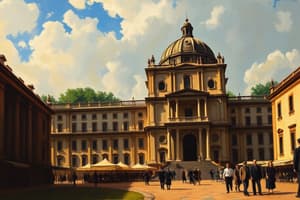Podcast
Questions and Answers
Qual foi o nome do presidente civil que foi removido pelas forças militares após meses de protestos em abril de 1969?
Qual foi o nome do presidente civil que foi removido pelas forças militares após meses de protestos em abril de 1969?
- Ranieri Mazzelli
- Arthur Costa e Silva
- Médici (correct)
- João Goulart
Quanto tempo durou a ditadura militar no Brasil?
Quanto tempo durou a ditadura militar no Brasil?
- 5 anos
- 10 anos
- 15 anos
- 21 anos (correct)
O que motivou o crescimento econômico durante a ditadura?
O que motivou o crescimento econômico durante a ditadura?
- Aumento do investimento externo
- Aumento da exportação
- Aumento da diversificação da economia (correct)
- Aumento da concentração de renda
O que foi decretado pelas forças militares em dezembro de 1968?
O que foi decretado pelas forças militares em dezembro de 1968?
Quais das seguintes ações é permitida pelo texto?
Quais das seguintes ações é permitida pelo texto?
Qual foi o nome do general que assumiu o cargo de presidente após a remoção de Ranieri Mazzelli?
Qual foi o nome do general que assumiu o cargo de presidente após a remoção de Ranieri Mazzelli?
Quais das seguintes ações é permitida pelo texto?
Quais das seguintes ações é permitida pelo texto?
Quais das seguintes ações é permitida pelo texto?
Quais das seguintes ações é permitida pelo texto?
Qual foi o nome do presidente civil que foi removido pelas forças militares após meses de protestos em abril de 1969?
Qual foi o nome do presidente civil que foi removido pelas forças militares após meses de protestos em abril de 1969?
Quais das seguintes ações é permitida pelo texto?
Quais das seguintes ações é permitida pelo texto?
Flashcards are hidden until you start studying
Study Notes
- In 1964, Brazil experienced a military dictatorship that lasted for 21 years.
- The dictatorship was marked by political suppression, imprisonment and torture of opponents, and the imposition of prior censorship of the media.
- Economic growth during this time was fueled by a rapid diversification and modernization of the economy, with income and wealth concentration, external debt, and foreign investment.
- In 1968, after years of protests, the military removed the civilian president, Ranieri Mazzelli, and replaced him with the more authoritarian General Arthur Costa e Silva.
- Costa e Silva's two-month administration saw the legalization of political actions not mentioned in the Constitution, as well as increasing repression against the opposition.
- In December 1968, the military enacted the more extensive and authoritarian AI-5, which revoked many constitutional rights.
- In April 1969, after months of protests, the military removed Costa e Silva and replaced him with a civilian, Médici.
- The military would go on to rule Brazil for the next three decades.
- The text establishes that the government has the power to enact laws and take other actions it deems necessary to protect the nation's security.
- The text also establishes that the government has the power to suspend certain rights and freedoms as it deems necessary.
- The text also allows the military to take specific actions to repress the nation's enemies.
- The text also allows the government to censor the media.
- The text also allows the government to suspend the right to habeas corpus in cases of political crimes.
- The text also allows the government to remove elected officials from office.
Studying That Suits You
Use AI to generate personalized quizzes and flashcards to suit your learning preferences.





